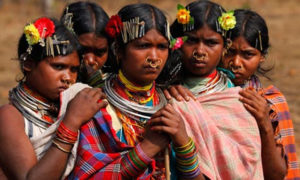Prof. Gopal Mohanty

A proud yet sad Odia reminisces the gradual downfall and neglect faced by his motherland down the ages.
Ignored was Odisha – her people, language, architecture and culture – and is still being ignored.
Ignored, neglected and quite often humiliated. Odisha’s glory of the past was overshadowed, Odia language was almost to be subsumed under Bengali, her people’s simplicity, generousity and tolerance were misunderstood as to be naïve, a sign of ignorance and lack of masculinity, and her art and culture were sidetracked for being rustic. Under sustained pressure from outside rulers, Odisha’s intellectual and creative force shrunk to be hidden quite often inside the rural ethos.
However, the smouldering desire for being counted and to have ‘self dignity’ as a natural yarning for any individual gave rise to Oriya nationalistic movement during late nineteenth century. Its purpose was to unite fragmented parts of Odia speaking people who were living in other States as second-class citizens and create one State – Odisha – for them. It is well known that Madhu Babu and Fakir Mohan among others were leading the movement and eventually Orissa (as it was called then) came into existence in 1936.
The objective of the movement was also to support India’s independence but it was a question of priority to form Orissa first because of the apprehension that in an independent India Odias would not have the same self dignity as say, Bengalis, Hindustanis or Telugus and the idea of forming Orissa later might be ignored.
 Odia nationalism is evoked mainly for preservation of Odia language and by people’s emotional attachment to Lord Jagannath. The Jagannath philosophy is liberal and eclectic in the sense that it assimilates the important postulates of almost all religions including that of tribals. It espouses universal humanism – we all are children of God – and induces mutual respect among each other. This principle is reflected in the society to make it inclusive and not to neglect or dehumanize others, unlike customary in many parts of India. For example, caste based division is less felt in Odisha in contrast to several other States.
Odia nationalism is evoked mainly for preservation of Odia language and by people’s emotional attachment to Lord Jagannath. The Jagannath philosophy is liberal and eclectic in the sense that it assimilates the important postulates of almost all religions including that of tribals. It espouses universal humanism – we all are children of God – and induces mutual respect among each other. This principle is reflected in the society to make it inclusive and not to neglect or dehumanize others, unlike customary in many parts of India. For example, caste based division is less felt in Odisha in contrast to several other States.
India’s civilization and culture have been a continuous process of ever absorbing and assimilating changes because the fundamental principle of ‘unity in diversity’ has been their core. Interestingly, people of Odisha have found their beliefs to be akin to this principle. That’s why when Odisha’s nationalism movement started it appealed to many – appeal for mutual respect and not to get ignored.
India’s cherished model of democracy followed through the principle of ‘unity in diversity’ is a pride and that’s why it can be called ‘Incredible India’. The country is being curiously watched by rest of the world. Canada’s adoption of pluralism is very close to India’s model.
At present the very values for which Odia nationalism movement was fought are being challenged.
Now in many schools learning Hindi has been given a priority even to the extent of neglecting Odia which may eventually make Odia learning redundant. The other concern is that the liberal religious beliefs in Odisha may give away to a narrow set of prescribed beliefs through the recent trend of inducing the concept of uniformity by majortization (a twisted concept of equality), that is to accept what majority people are following by ignoring anything different including that inherently present in Jagannath philosophy.
A possible threat to sustain India’s diversities is looming and there is a good chance that Odisha will be ignored again!
Consider a possible ill consequence of being ignored for long. In spite of the lofty ideals prevalent in Odisha’s spiritual beliefs, the societal attitude ironically is often trapped by the so-called mother-in-law and daughter-in-law syndrome – the mother-in-law who was victimized during her period of being a daughter-in-law, victimizes her own daughter-in-law – one who was neglected neglects others instead of being generous.
Having been ignored by others, the attitude of people of Odisha should be or at least be developed not to ignore or neglect any deserving person within their own group.
A few cases are given below to illustrate how deserving persons have been ignored.
 Babaji Padma Charan Das (1868 – 1940) was a contemporary of Utkal Gauraba Madhu Sudan Das and Vyasakabi Fakir Mohan Senapati. Born in Soro, Balasore he had his B.A. degree from Ravenshaw College. From his childhood he was very religious and became a Vaishnava to spend a large part of his life in Vrindavan.
Babaji Padma Charan Das (1868 – 1940) was a contemporary of Utkal Gauraba Madhu Sudan Das and Vyasakabi Fakir Mohan Senapati. Born in Soro, Balasore he had his B.A. degree from Ravenshaw College. From his childhood he was very religious and became a Vaishnava to spend a large part of his life in Vrindavan.
During his time Odisha had already adopted Radha-Krushna devotional (Bhakti) cult and the religio-cultural scene in Odisha was heavily influenced by Gaudiya Vashnavism. Practically every village had a Radha-Krushna temple and devotional songs in praise of divine love of Radha-Krushna were sang as part of religious practice, called Kirtan. The language of songs was Bengali and the tune (swara) was of Gaudiya kirtan. At this juncture Babaji Padma Charan felt a need for “Odia Kirtan” and became its pioneer by writing four books ‘Odia Kirtan’ part 1 – 2 and ‘Sangita Harabali’ Part 1-2 and publishing these during 1913 -17.
These were written in Odia and were in traditional ‘raga’s like basant, khambaj, kamodi, purabi. There was another important aspect of Padma Charan’s compositions. During any of Radha-Krushna related festival such as Chandana, Jhulana, Raasa and Dola, it was customary (even now) particularly in Puri and the vicinity to have gotipua dances accompanied by Champu, Odishi and Chhanda without any reference to any particular festival or the season. Babaji composed lyrics specifically meant for each festival. In Sangita Harabali, this feature is highlighted with abundant lyrical description of the season and the festival, in addition to the usual theme of divine love. What is appealing in his Kirtan is that common folks in Odisha can take part in singing while in gotipua dances they will be mere spectators.
Besides his pioneering contribution to Odia Kirtan, Babji wrote 24 books during his life time, of which three were dramas – Shree Prataprudra Deva, Kansa Badha and Shree Shree Radha Govinda Keli Bilasa – which predate dramas of eminent Vaishnav Pani.
It seems Padma Charan’s passion for Odia language and Odia music was so deep that he created “Odia Kirtan” and was a pioneer in enriching Odia ‘Bhakti’ literature. Sadly, after his death he has been completely ignored.
 It is no exaggeration that the name of Akshaya Mohanty has been permanently etched in modern Odia music – he is considered to be its father. Soon after 1955, there was a new kind of spring and an uproar in the world of Odia music, which was neither a freshness induced in traditional music nor was revamp of folk music.
It is no exaggeration that the name of Akshaya Mohanty has been permanently etched in modern Odia music – he is considered to be its father. Soon after 1955, there was a new kind of spring and an uproar in the world of Odia music, which was neither a freshness induced in traditional music nor was revamp of folk music.
It was a never-done-before bold experiment of expressing rural romantic sentiment in modern lyrical rendering.
Partha Sarathi Mohapatra’s “mo rangalata rusichhi” in the voice of Akshaya Mohanty just had the never-seen-before magical effect on the youth’s tender mind. Even one could hear the riksha puller humming “mo rangalata rusichhi” in lanes of Cuttack and under the open sky. Partha (Bulu Bhai) was the lyricist and Akshaya (Khoka Bhai) was the vocalist. The pair’s musical charm spread like wild fire. Bulu Bhai and Khoka Bhai were like two flowers in one stem – then…
Bulu Bhai had an untimely death in 1976.
Khoka Bhai became immortal and Bulu Bhai remained incognito.
 Another instance relates to emergence and recreation of Odissi dance. When we think of Odissi dance, we are immediately reminded of Guru Kelu Charan Mohapatra among others. The dance is a beautiful harmonious blend of music and choreography. Kelu Babu’s many dance productions were the result of two persons sitting together at odd hours in the night – he with the music composer Bhubaneswar Mishra. In any dance performance one can feel within the charming impact of Bhubaneswar Babu’s music composition. Both these men were also like two flowers in one stem. The glory of Odissi dance has spread all over the world. Yet Bhubaneswar Babu’s name hardly receives any significance.
Another instance relates to emergence and recreation of Odissi dance. When we think of Odissi dance, we are immediately reminded of Guru Kelu Charan Mohapatra among others. The dance is a beautiful harmonious blend of music and choreography. Kelu Babu’s many dance productions were the result of two persons sitting together at odd hours in the night – he with the music composer Bhubaneswar Mishra. In any dance performance one can feel within the charming impact of Bhubaneswar Babu’s music composition. Both these men were also like two flowers in one stem. The glory of Odissi dance has spread all over the world. Yet Bhubaneswar Babu’s name hardly receives any significance.
The urbanized Odisha neglects and even exploits rural Odisha and has become the cause of destruction of rural economy. Non-tribals do the same to tribals.
The attitude of neglect can be explained mostly by the prevalent hierarchal ordering system ingrained in feudalism and the influence of neighbouring regions on sustaining class-caste system. Both are maintained by ignoring or pushing down someone deserving (crab mentality).
These two factors apparently have a strong restraining impact on the humanitarian principle of equality of Jagannath philosophy. Yet to her credit, Odisha remembers and eulogizes simple folks like milk maid Manika, Bhima Bhoi and Sal Beg.
 Can the people of Odisha remind themselves not to be ignored while respecting others and cultivate the attitude not to ignore their own people? They do not want to lose their identity and at the same time are willing to work for the concept of ‘Unity in Diversity’.
Can the people of Odisha remind themselves not to be ignored while respecting others and cultivate the attitude not to ignore their own people? They do not want to lose their identity and at the same time are willing to work for the concept of ‘Unity in Diversity’.
(The author is a Professor Emeritus in Mathematics and Statistics at McMaster University, Canada. Throughout his life he has taken active parts in different socio-cultural organizations and social development organizations, one being SEEDS, a NA based NGO which is formed by expatriates from Odisha. He is associated with OSA just after its formation. He takes special interest in cultural aspects of Odisha and of people in general. He believes in individualism particularly directed towards serving the humanity. With that spirit he is presently working with Mahila Shanti Sena(MSS), a movement to build peace through women-led and community-based empowerment.)


















